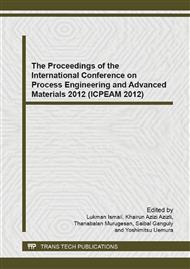[1]
K.J. Bell, Two-phase flow regime consideration in condenser and vapour design, Int. Commun. Heat Mass Transfer 15 (1988) 429-448.
DOI: 10.1016/0735-1933(88)90042-5
Google Scholar
[2]
P.L. Spedding, D.R. Spence, Prediction of Holdup in Two-Phase Flow, Int. J. Engg. Fluid Mech. 1 (1988) 67-82.
Google Scholar
[3]
G.B. Wallis, One dimensional two-phase flow. McGrew-Hill Book Co. Inc., New York, (1969).
Google Scholar
[4]
G.W. Govier, K. Aziz, The Flow of Complex Mixtures in Pipes. Van Nostran Reinhold, New York City, (1972).
Google Scholar
[5]
G. Hestroni, Handbook of Multiphase Systems. Hemisphere Publishing Corp., Washington, DC, (1982).
Google Scholar
[6]
C.T. Crowe, Multiphase Flow Handbook. CRC Press, Boca Raton, (2006).
Google Scholar
[7]
Y. Taitel, A.E. Dukler, A model for prediction flow regime transition in horizontal and near horizontal gas–liquid, AICHE J. 22 (1976) 47-55.
DOI: 10.1002/aic.690220105
Google Scholar
[8]
J. Xiao, O. Shoham, J. Brill, A comprehensive model for two-phase flow in pipelines, The 65th SPE Annual Technical Conference and Exhibition, SPE 20631, New Orleans, Sep, (1990).
Google Scholar
[9]
A.M. Ansari, N.D. Sylvester, O. Shoham, J.P. Brill, A comprehensive mechanistic model for upward two phase flow in wellbores, SPE Prod. Facil., pp.143-152, May, (1994).
DOI: 10.2118/20630-pa
Google Scholar
[10]
A.S. Kaya, C. Sarica, J.P. Brill, Comprehensive mechanistic model of two-phase flow in deviated wells, SPE Annual Technical Conference and Exhibition. SPE 56522, Houston, Oct, (1999).
DOI: 10.2118/56522-ms
Google Scholar
[11]
H.Q. Zhang, Q. Wang, C. Sarica, J.P. Brill, Unified model for gas–liquid pipe flow via slug dynamics. Part 1: Model development, J. Energy Res. Tech. 125 (2003) 266-273.
DOI: 10.1115/1.1615246
Google Scholar
[12]
H.Q. Zhang, Q. Wang, C. Sarica, J.P. Brill, Unified model for gas–liquid pipe flow via slug dynamics. Part 1: Model validation, J. Energy Res. Tech. 125 (2003) 274-283.
DOI: 10.1115/1.1615618
Google Scholar
[13]
S.K. Das, Studies on two-phase gas-non-Newtonian liquid flow in horizontal, vertical tubes and bends, Ph.D. thesis, Dept. Chem. Engg., Indian Institute of Technology, Kharagpur, India, (1988).
Google Scholar
[14]
Z. Khatib, J.F. Richardson, Vertical co-current flow of air and shear-thinning suspensions of kaolin, Chem. Eng. Res. Des. 62 (1984) 139-154.
Google Scholar
[15]
S.K. Das, M.N. Biswas, A.K. Mitra, Holdup for two-phase flow of gas-non-newtonian liquid mixtures in horizontal and vertical pipes, Can. J. Chem. Eng. 70 (1992) 431-437.
DOI: 10.1002/cjce.5450700304
Google Scholar
[16]
S.K. Das, M.N. Biswas, A.K. Mitra, Pressure losses in two-phase gas-non-newtonian liquid flow in a vertical tube, Chem. Engg. Commun. 135 (1995) 229-237.
DOI: 10.1080/00986449508936349
Google Scholar
[17]
M. Dziubinski, A general correlation for the two-phase pressure drop in intermittent flow of gas and non-newtonian liquid mixtures in a pipe, Trans. Chem. Eng. Res. Des. 73 (1995) 528-533.
DOI: 10.1016/s0301-9322(97)88191-8
Google Scholar
[18]
M. Dziubinski, H. Fidos, M. Sosno, The flow pattern map of a two-phase non-Newtonian liquid-gas flow in the vertical pipe, Int. J. Multiphase Flow 30 (2004) 551-563.
DOI: 10.1016/j.ijmultiphaseflow.2004.04.005
Google Scholar
[19]
D.L. Himmelblau, Application of artificial neural network in Chemical Engineering, Korean. J. Chem. Engg. 17 (2000) 373-392.
Google Scholar
[20]
I.A. Basheer, M.J. Hajmeer, Artificial neural networks: fundamentals, computing, design, and application, J. Microbiol Methods 43 (2000) 3-31.
DOI: 10.1016/s0167-7012(00)00201-3
Google Scholar
[21]
N. Bar, S.K. Das, Comparative study of friction factor by prediction of frictional pressure drop per unit length using empirical correlation and ANN for gas-non-Newtonian liquid flow through 180° circular bend, Int. Rev. Chem. Engg. 3 (2011).
DOI: 10.1615/interjfluidmechres.v39.i5.40
Google Scholar
[22]
N. Bar, S.K. Das, Gas-non-Newtonian Liquid Flow through Horizontal Pipe - Gas Holdup and Frictional Pressure Drop Prediction using Multilayer Perceptron, American J. Fluid Dynamics 2 (2012) 7-16.
DOI: 10.5923/j.ajfd.20120203.01
Google Scholar
[23]
N. Bar, A.B. Biswas, M.N. Biswas, S.K. Das, Prediction of Pressure Drop for Gas-non-Newtonian Liquid Flow through Piping Components, Ind. Eng. Chem. Res. 49 (2010) 9423-9429.
DOI: 10.1021/ie1007739
Google Scholar
[24]
S.K. Das, N. Bar, Hydrodynamics of Gas-non-Newtonian Liquid Flow and ANN Predictibility, Lambart Academic Publishing. Saarbrücken, Germany, (2013).
Google Scholar
[25]
N. Bar, S.K. Das, Frictional Pressure Drop for Gas-Non-Newtonian Liquid Flow through 90° and 135° circular bend: Prediction Using Empirical Correlation and ANN, Int. J. Fluid Mech. Res. 39 (2013) 416-437.
DOI: 10.1615/interjfluidmechres.v39.i5.40
Google Scholar


